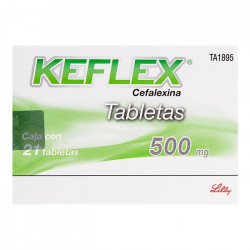Keflex (cephalexin) Coupons, Discounts & Cost
Keflex (cephalexin) is a first-generation cephalosporin agent. One way to save money on the Keflex (cephalexin) retail cost regardless of income and insurance status is to use Keflex coupons or discount cards from RXCoupons. Use our Cephalexin coupons at your online pharmacy and receive up to 75% off the sale price each time you refill your prescription.
What should I know about Keflex (cephalexin)?
Keflex (cephalexin) is a first-generation cephalosporin agent. The drug violates the formation and function of membranes of the microorganisms. It is active against certain gram-positive and gram-negative microorganisms, including staphylococci, pneumococci, streptococci, E. coli, Salmonella, Haemophilus influenzae, Shigella, Klebsiella. Mycobacterium tuberculosis, Enterococcus species and Enterobacter species are resistant to cephalexin.
Keflex (cephalexin) pharmacological effect
Keflex (cephalexin) has antibacterial and bactericidal effect. The active substance of the drug penetrates into tissues (lung, kidney, liver, heart) and passes through the placenta. It is active against gram-positive organisms (staphylococci, streptococci, pneumococci, diphtheria bacilli) and some gram-negative bacteria (meningococci and gonococci, E.coli, Salmonella, Shigella, Klebsiella, etc.).
Keflex (cephalexin) indications for use
Treatment of infections caused by microorganisms sensitive to cephalexin: mild to moderate upper respiratory tract infections (otitis, tonsillitis, sinusitis), upper and lower respiratory tract infections (pharyngitis, pneumonia, bronchopneumonia, lung abscess), urinary system infections (acute and chronic pyelonephritis, cystitis, urethritis, prostatitis, epididymitis, gynecological infections (gonorrhea), skin and soft tissue infections (furunculosis, abscess, pyoderma, lymphangitis), bone and joint infections (acute and chronic osteomyelitis).
Keflex (cephalexin) dosing and administration
Keflex (cephalexin) is prescribed at a dose of 1-4 g per day (generally 250 mg every 6 hours). Keflex tablets should be taken 30-60 minutes before meals with water.
Patients with streptococcal pharyngitis, skin infections, and uncomplicated cystitis (patients over 15 years) should take 500 mg every 12 hours for 7-24 days. Children over 1 year should take 25-50 mg/kg/day in 2 divided doses. The dosage can be doubled in case of severe infections.
Children under 10 years of age should use cephalexin in the form of suspension for oral administration. The average daily dose is 25-100 mg/kg per day (4 times). In the case of otitis media, the recommended dose is of 75 mg/kg/day (4 times).
Take the drug at least 2 more days after clinical improvement.
Keflex (cephalexin) contraindications
Hypersensitivity (including to penicillins, cephalosporins, carbapenems), lactation, pregnancy. Keflex should not be used during pregnancy and lactation unless absolutely necessary.
Keflex (cephalexin) side effects
Nausea, vomiting, diarrhea, dry mouth, loss of appetite, abdominal pain, pseudomembranous colitis, cholestatic jaundice, hepatitis, headaches, dizziness, weakness, leukopenia, neutropenia, thrombocytopenia, goiter, allergic reactions, itching, skin rash, urticaria, angioedema, anaphylactic shock.
Digestive system: pain in the abdominal area, dry mouth, diarrhea, nausea, vomiting, toxic hepatitis, anorexia, cholestatic jaundice, pseudomembranous enterocolitis, intestinal candidiasis.
Nervous system: dizziness, weakness, headache, convulsions, hallucinations.
Urogenital system: vaginitis, interstitial nephritis, bacterial vaginosis, itching of the genital and anal skin.
Blood: leukopenia, thrombocytopenia, neutropenia.
Musculoskeletal system: arthritis, arthralgia.
Allergic reactions: erythema, hives, rash, angioedema, eosinophilia, anaphylactic shock, Stevens-Johnson syndrome, toxic epidermal necrolysis.
Keflex (cephalexin) interactions
Cephalexin should not be combined with anticoagulants (increased risk of bleeding).
Nonsteroidal anti-inflammatory drugs slow down the excretion of cephalexin.
Furosemide, ethacrynic acid and nephrotoxic antibiotics increase the risk of kidney damage.
Salicylates and indomethacin may slow excretion of the drug.
Loop diuretics increase the risk of nephrotoxicity.
Aminoglycoside antibiotics increase the risk of neurotoxicity.
Cephalexin increases the concentration of metformin.
Cephalexin reduces the effectiveness of oral contraceptives.
Keflex (cephalexin) overdose
In case of overdose, patients may experience dizziness, cramps, nausea, vomiting, diarrhea, epigastric pain, hematuria, encephalopathy. If overdose occurs, symptomatic treatment is recommended.
Keflex (cephalexin) special instructions
Patients with impaired renal function should consult a doctor for his opinion and advice about how to calculate the correct dose of Keflex. The drug is used with caution in patients with allergic reactions to penicillin antibiotics.
Keflex (cephalexin) storage conditions
Keep in a dry, dark place, at a temperature of 15-25° C.

